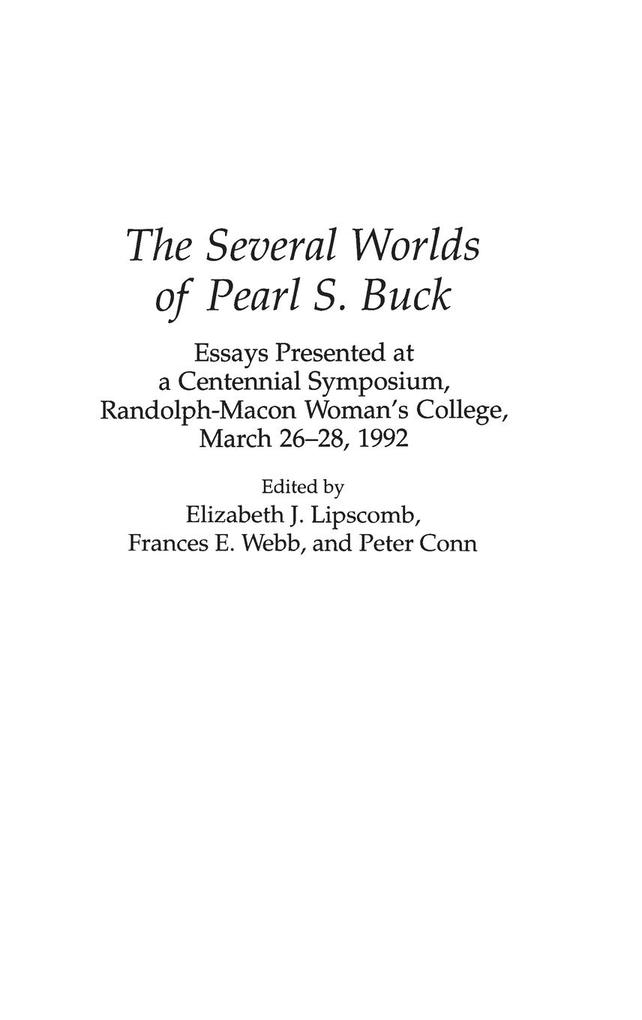
Zustellung: Do, 22.05. - Mo, 26.05.
Versand in 1-2 Wochen
VersandkostenfreiBestellen & in Filiale abholen:
Pearl Buck made important contributions as a humanitarian and an advocate of racial equality and women's rights. She did much to change American attitudes toward persons with mental retardation and toward mixed-race children. She was a major force in shaping American views of Asia, particularly China, during the 1930s and 1940s. Until 1993, she was first American woman to win both the Pulitzer Prize and the Nobel Prize for Literature. The 13 essays in this book, the first such collection on Buck to be published in the United States, view her from historical, humanitarian, and literary perspectives.
Inhaltsverzeichnis
Illustrations
Preface
Introduction: Rediscovering Pearl S. Buck by Peter Conn
Keynote Adress: Pearl S. Buck and the American Quest for China by James C. Thomson, Jr.
Historical Perspectives
The Good Earth, Revolution, and the American Raj in China by Charles W. Hayford
Pearl S. Buck in Search of America by David D. Buck
Pearl S. Buck and American Women's History by John d'Entremont
Pearl S. Buck's Reception in China Reconsidered by Liu Haiping
Humanitarian Perspectives
East/West Ties: Amerasian Children and the Work of the Pearl S. Buck Foundation by Grace C. K. Sum
Welcome House: A Forty-Year History by Peter Conn
Buck's Writings on Handicapped Children by Deborah Clement Raessler
Literary Perspectives
Who's Afraid of Pearl S. Buck? by Jane M. Rabb
Pearl S. Buck and American Literary Culture by Peter Conn
Pearl S. Buck's The Good Earth: The Novel as Epic by Pradyumna S. Chauhan
Scripting The Good Earth: Versions of the Novel for the Screen by James L. Hoban, Jr.
Selected Bibliography
Index
Illustrations
Nobel Prize Portrait
Senior College Portrait
Commemorative Stamp
White House Gala
With Amerasian Children
At Her Desk
MGM's The Good Earth
Preface
Introduction: Rediscovering Pearl S. Buck by Peter Conn
Keynote Adress: Pearl S. Buck and the American Quest for China by James C. Thomson, Jr.
Historical Perspectives
The Good Earth, Revolution, and the American Raj in China by Charles W. Hayford
Pearl S. Buck in Search of America by David D. Buck
Pearl S. Buck and American Women's History by John d'Entremont
Pearl S. Buck's Reception in China Reconsidered by Liu Haiping
Humanitarian Perspectives
East/West Ties: Amerasian Children and the Work of the Pearl S. Buck Foundation by Grace C. K. Sum
Welcome House: A Forty-Year History by Peter Conn
Buck's Writings on Handicapped Children by Deborah Clement Raessler
Literary Perspectives
Who's Afraid of Pearl S. Buck? by Jane M. Rabb
Pearl S. Buck and American Literary Culture by Peter Conn
Pearl S. Buck's The Good Earth: The Novel as Epic by Pradyumna S. Chauhan
Scripting The Good Earth: Versions of the Novel for the Screen by James L. Hoban, Jr.
Selected Bibliography
Index
Illustrations
Nobel Prize Portrait
Senior College Portrait
Commemorative Stamp
White House Gala
With Amerasian Children
At Her Desk
MGM's The Good Earth
Produktdetails
Erscheinungsdatum
30. Mai 1994
Sprache
englisch
Seitenanzahl
184
Herausgegeben von
Peter Conn, Elizabeth Lipscomb, Frances Webb
Verlag/Hersteller
Produktart
gebunden
Gewicht
446 g
Größe (L/B/H)
240/161/15 mm
ISBN
9780313291524
Entdecken Sie mehr
Bewertungen
0 Bewertungen
Es wurden noch keine Bewertungen abgegeben. Schreiben Sie die erste Bewertung zu "The Several Worlds of Pearl S. Buck" und helfen Sie damit anderen bei der Kaufentscheidung.










